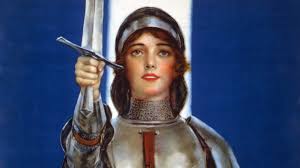If you are using Chrome, click the red hand button at the top right of the screen:

Then select: Don't run on pages on this site
If you do it correctly, the red hand will turn to green and you will no longer see this message.


|
 Journal |
 Bite PrincessMradu |
 Stalk PrincessMradu |
"If ever I do escape, no one shall reproach me with having broken or violated my faith, not having given my word to any one, whosoever it may be." - Joan of Arc
Joan of Arc, nicknamed "The Maid of Orléans," was born in 1412 in Domrémy, Bar, France. A national heroine of France, at age 18 she led the French army to victory over the English at Orléans. Captured a year later, Joan was burned at the stake as a heretic by the English and their French collaborators. She was canonized as a Roman Catholic saint more than 500 years later, on May 16, 1920.
Historical Background
At the time of Joan of Arc’s birth, France was embroiled in a long-running war with England known as the Hundred Years’ War; the dispute began over who would be the heir to the French throne. By the early 15th century, northern France was a lawless frontier of marauding armies.
Early Years
Joan of Arc was born in 1412, in Domremy, France. The daughter of poor tenant farmers Jacques d’ Arc and his wife, Isabelle, also known as Romée, Joan learned piety and domestic skills from her mother. Never venturing far from home, Joan took care of the animals and became quite skilled as a seamstress.
In 1415, King Henry V of England invaded northern France. After delivering a shattering defeat to French forces, England gained the support of the Burgundians in France. The 1420 Treaty of Troyes, granted the French throne to Henry V as regent for the insane King Charles VI. Henry would then inherit the throne after Charles’s death. However, in 1422, both Henry and Charles died within a couple of months, leaving Henry’s infant son as king of both realms. The French supporters of Charles’ son, the future Charles VII, sensed an opportunity to return the crown to a French monarch.
Around this time, Joan of Arc began to have mystical visions encouraging her to lead a pious life. Over time, they became more vivid, with the presence of St. Michael and St. Catherine designating her as the savior of France and encouraging her to seek an audience with Charles—who had assumed the title Dauphin (heir to the throne)—and ask his permission to expel the English and install him as the rightful king.
Meeting with the Dauphin
In May 1428, Joan’s visions instructed her to go to Vaucouleurs and contact Robert de Baudricourt, the garrison commander and a supporter of Charles. At first, Baudricourt refused Joan’s request, but after seeing that she was gaining the approval of villagers, in 1429 he relented and gave her a horse and an escort of several soldiers. Joan cropped her hair and dressed in men’s clothes for her 11-day journey across enemy territory to Chinon, the site of Charles’s court.
At first, Charles was not certain what to make of this peasant girl who asked for an audience and professed she could save France. Joan, however, won him over when she correctly identified him, dressed incognito, in a crowd of members of his court. The two had a private conversation during which it is said Joan revealed details of a solemn prayer Charles had made to God to save France. Still tentative, Charles had prominent theologians examine her. The clergymen reported they found nothing improper with Joan, only piety, chastity and humility.
The Battle of Orléans
Finally, Charles gave the 17-year-old Joan of Arc armor and a horse and allowed her to accompany the army to Orléans, the site of an English siege. In a series of battles between May 4 and May 7, 1429, the French troops took control of the English fortifications. Joan was wounded, but later returned to the front to encourage a final assault. By mid-June, the French had routed the English and , in doing so, their perceived invincibility as well.
Although it appeared that Charles had accepted Joan’s mission, he did not display full trust in her judgement or advice. After the victory at Orléans, she kept encouraging him to hurry to Reims to be crowned king, but he and his advisors were more cautious. However, Charles and his procession finally entered Reims, and he was crowned Charles VII on July 18, 1429. Joan was at his side, occupying a visible place at the ceremonies.
Capture and Trial
In the spring of 1430, King Charles VII ordered Joan of Arc to Compiègne to confront the Burgundian assault. During the battle, she was thrown off her horse and left outside the town’s gates. The Burgundians took her captive and held her for several months, negotiating with the English, who saw her as a valuable propaganda prize. Finally, the Burgundians exchanged Joan for 10,000 francs.
Charles VII was unsure what to do. Still not convinced of Joan’s divine inspiration, he distanced himself and made no attempt to have her released. Though Joan’s actions were against the English occupation army, she was turned over to church officials who insisted she be tried as a heretic. She was charged with 70 counts, including witchcraft, heresy and dressing like a man.
Initially the trial was held in public, but it went private when Joan of Arc bettered her accusers. Between February 21 and March 24, 1431, she was interrogated nearly a dozen times by a tribunal, always keeping her humility and steadfast claim of innocence. Instead of being held in a church prison with nuns as guards, she was held in a military prison. Joan was threatened with rape and torture, though there is no record that either actually occurred. She protected herself by tying her soldiers’ clothes tightly together with dozens of cords. Frustrated they could not break her, the tribunal eventually used her military clothes against her, charging that she dressed like a man.
Death Burned at the Stake
On May 29, 1431, the tribunal announced Joan of Arc was guilty of heresy. On the morning of May 30, she was taken to the marketplace in Rouen and burned at the stake, before an estimated crowd of 10,000 people. She was 19 nineteen years old. One legend surrounding the event tells of how her heart survived the fire unaffected. Her ashes were gathered and scattered in the Seine.
Retrial and Legacy
After Joan's death, the Hundred Years’ War continued for another 22 years. King Charles VII ultimately retained his crown, and he ordered an investigation that in 1456 declared Joan of Arc to be officially innocent of all charges and designated a martyr. She was canonized as a saint on May 16, 1920, and is the patron saint of France.
| Member Since: | Feb 21, 2018 |
| Last Login: | Sep 09, 2020 |
| Times Viewed: | 2,941 |
| Times Rated: | 142 |
| Rating: | 9.163 |
